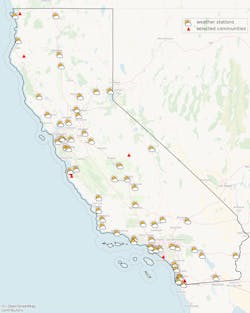California’s wildfires — and consequent power shutoffs — have created a strong argument for microgrids in the state. But many of the early microgrids relied on diesel generation. Yes, they improved energy reliability but they also produced carbon emissions.
An international team led by the Lawrence Berkeley National Laboratory (LBNL) says that solar-storage microgrids can do the job without the carbon and at a cheaper cost than electricity from the grid.
The study modeled clean energy microgrids at seven California communities that are vulnerable to wildfires. The microgrids were designed to run on solar and storage for at least 60% of the year. Fossil generators acted as a secondary source.
The team focused on households where heating and cooling account for most of the energy use. There is good reason for this. Air conditioning or heating loss has led to deaths in Texas, Florida and Europe in recent years.
“We’re really talking about equity here”
Often it's the most disadvantaged that are hardest hit during power outages. But it turns out it doesn’t have to be that way. Clean energy microgrids are not gold-plated technology, as some think, but can be cheaper than grid power. The study pegged their cost at 15-30 cents/kWh, compared with an average of 25 cents/kWh for grid electricity in California.
The price differentiation is important because communities at risk for wildfires tend to be situated in what the study calls the “wildland-urban interface” or WUI. In California, these communities are typically not wealthy.
“We’re really talking about equity here. The technology can be really good, but at the end of the day, if people can’t afford it then nothing happens,” said Tianzhen Hong, a study co-author and senior scientist in LBNL’s Building Technology & Urban Systems Division.
Keeping WUI populations safe during wildfires isn’t easy because they often lack infrastructure. Transportation may be scant and hospitals far away. So these areas depend heavily on multiple local infrastructure systems, which are highly dependent on energy.
“For example, a reliable electricity supply is needed to support residents’ daily needs, telecommunications, traffic control and operations, and functioning of critical organizations such as hospitals in wildfire emergencies,” the paper said.
Unfortunately, the infrastructure — including the electric grid — may be old and lacking. And that in itself can pose a potential fire risk according to the study.
“At least five of the 20 most destructive California fires have been attributed to power line problems, including the 2018 Camp Fire, which claimed the lives of 85 people,” the study said.
A partial solution to PSPS — for now
For those in California who are subject to public safety power shutoffs (PSPS), clean microgrids are important because they can offer up power from on-site electricity sources.
However, don’t expect microgrids to completely protect California from outages during PSPS events — at least not yet.
“The levelized cost and renewable energy generation curtailments [waste of renewable energy] become notably high when attempting to eliminate public safety power shutoffs completely,” the study said. That could change with a “notable reduction” in energy storage costs.
Practical use of the research
Hong described the study as the first detailed, state-level look into how clean energy microgrids minimize outages for vulnerable communities and the cost. It offers models for communities and developers to:
Locate communities that could benefit.
Understand how to design clean energy microgrids.
Figure out the cost to reduce outages below a desired threshold.
As a next step, the researchers hope to work with governments, utilities and other stakeholders to help design microgrids based on their data.
Moreover, the study’s value isn’t limited to California. More than 46 million people in 70,000 US communities live in WUI areas and face wildfire risks. For those interested in LBNL’s model, the research is free and available to the public on Science Direct. See Optimal design of microgrids to improve wildfire resilience for vulnerable communities at the wildland-urban interface.
Track news about solar and storage microgrids. Subscribe to the free Microgrid Knowledge Newsletter.









